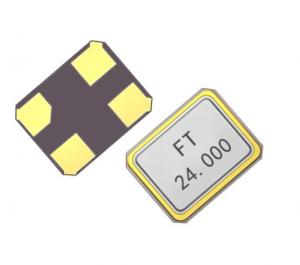“What is Tsx 3225-How to select the suitable oscillator for your design”
What is Tsx 3225-How to select the suitable oscillator for your design:
This guide will inform you about “Tsx 3225” and “How to select the suitable oscillator for your design.” Get ready to know interesting information about Tsx 3225 and oscillator selection strategy.

What is Tsx 3225 oscillator:
Tsx3225 is basically a crystal unit. Tsx 3225 is also used in many crystal oscillators. Surface-mounting crystals from the TSX-3225 Series are characterized by their very diminutive size and low profile.
Specs:
- Crystal Package Type- Miniature Size Low Profile Ceramic SMD 3.2 X 2.5 X 0.6 mm
- Frequency-000 ~ 48.000 MHz
- Tolerance-@25C F: +/-10ppm E: +/-15ppm
- Load Capacitance:AC: 9pF AJ: 8pF AS: 8.5pF B: 16pF C: 18pF W: 12pF
- Packaging:Bulk, cut tape, reel, mouse reel
How to select a suitable oscillator for your design?
It is simple to harm a system with the incorrect crystal oscillator, which is usually ignored since it is one of the final components a designer checks. It makes it one of the most likely causes of system failure. In addition, it may be challenging to differentiate between the many oscillators available on the market and the functions they provide. When looking for an oscillator, you should prioritize aspects of the device on your list of priorities. The answers you find will make it more likely that the criteria of your design will be satisfied. Besides choosing the oscillator according to your need, you also need to select oscillators from the right brands and best providers. To get exemplary oscillators, we recommend you CHINACHIPSUN oscillators!
Do you need an oscillator to complete your device?
Despite their superficial similarities, crystals and oscillators represent two distinct electronic components and technology types. Since the oscillator circuit that would normally power the quartz crystal is not there, there is no clock output. Instead, the electrical components necessary to drive the crystal are located in the attached apparatus.
A crystal oscillator, often known as an XO, consists of a quartz crystal, an oscillator circuit, an output driver, and perhaps a phase-locked loop. An XO not only offers signal outputs for CMOS, LVDS, and LVPECL, but it also provides a clock output at a set frequency. An oscillator may either drive a chip directly or use a buffer to feed it to accomplish the task of producing a large number of duplicates of a specific frequency. An oscillator is a whole clock generator that only produces a single output.
Most consumer and battery-powered applications use system-on-chip (SoC) devices. These chips include integrated oscillator circuitry and come equipped with a simple and inexpensive crystal. When dealing with high-end applications like data centers, telephony, industrial automation, and so on, it is common practice to use an external XO to provide the SoC’s internal PLLs with a reference time.
Off-chip clock sources are helpful because they give a unique and isolated reference clock that you may tweak to enable low-jitter operation with less crosstalk. Oscillators can reduce the influence of board-level noise on clock jitter via inherent noise rejection in the power supply, which is another significant advantage of oscillators.
To what degree is it imperative that jitter performance be maintained?
You may determine a clock signal’s purity by analyzing the movement’s temporal jitter. The smoother the transitions between frames, the less jitter there will be. Because the oscillator serves as a “heartbeat” for many different types of systems, having an output that is both clean and low in jitter is very desirable.
In the frequency domain, a phase-noise analyzer with RMS phase jitter integrated over a frequency range, such as from 12 kHz to 20 MHz, has the potential to quantify period jitter and cycle-to-cycle jitter.
In high-performance applications, excessive degrees of clock jitter may result in unacceptable bit-error rates (BER), missed system communication, or missing traffic. As a result, low-phase-jitter XOs with an RMS of 250 fs are necessary for use in these kinds of applications. As a consequence of this, it is usually desirable to start with a lower-jitter clock source to offer more considerable buffering. It is because, In an ideal setting, the specifications for oscillators have to include a maximum jitter value, integration band requirement, a phase noise mask requirement, and a spur requirement.
The jitter margin of an oscillator has to be sufficiently broad to accommodate any extra jitter induced further down the timing chain by buffers or other timing devices. It is essential to remember that specific XO datasheets only contain a “typical” jitter specification. Always choose the option with the lowest jitter; only after you’ve exhausted that choice should you consider looser choices as a possible means of cutting costs.
Will you be increasing or decreasing the number of posts you make?
Margin testing may be utilized to stress-test the system setup and hold durations. It is accomplished by purposely introducing a tiny frequency variation. The frequency that the designer will implement in the finished product is often unknown to the designer; nonetheless, they know that they need an oscillator to use as a reference.
Suppose the application requires the usage of fractional and integer clocks. In that case, you should seek a device with minimum jitter across both target frequencies to meet the application’s requirements.
An XO oscillator that can be programmed using I2 C is also helpful. These devices are the most adaptable in frequency since they provide various frequencies while producing a low amount of jitter.
Is maintaining frequency stability something that should be a priority?
The degree to which a temperature change may affect the oscillator’s output frequency while operating is referred to as the frequency stability of the oscillator. Timing mistakes are more likely to occur when there is a more significant variation in the frequency than what the application anticipates. Parts per million, or ppm, is the unit of measurement used to determine how stable a frequency is in proportion to its nominal frequency throughout a specific temperature range.
You may modify the temperature responses of oscillators during the manufacturing process by slicing quartz crystals at various angles. The output frequency is more steady over the temperature range when the ppm is lower than when it is higher.
In addition to the frequency’s stability, it is essential to understand how much an oscillator’s frequency may change. The complete assessment of likely frequency changes is referred to as total stability.
Conclusion:
The answers to the above question will help you choose a suitable oscillator. Whenever you purchase an oscillator, keep this guide in your mind, and Don’t forget to select the right brand. CHINACHIPSUN brand is highly reliable for oscillators, crystals, crystal filters, ceramic units, and much more!
